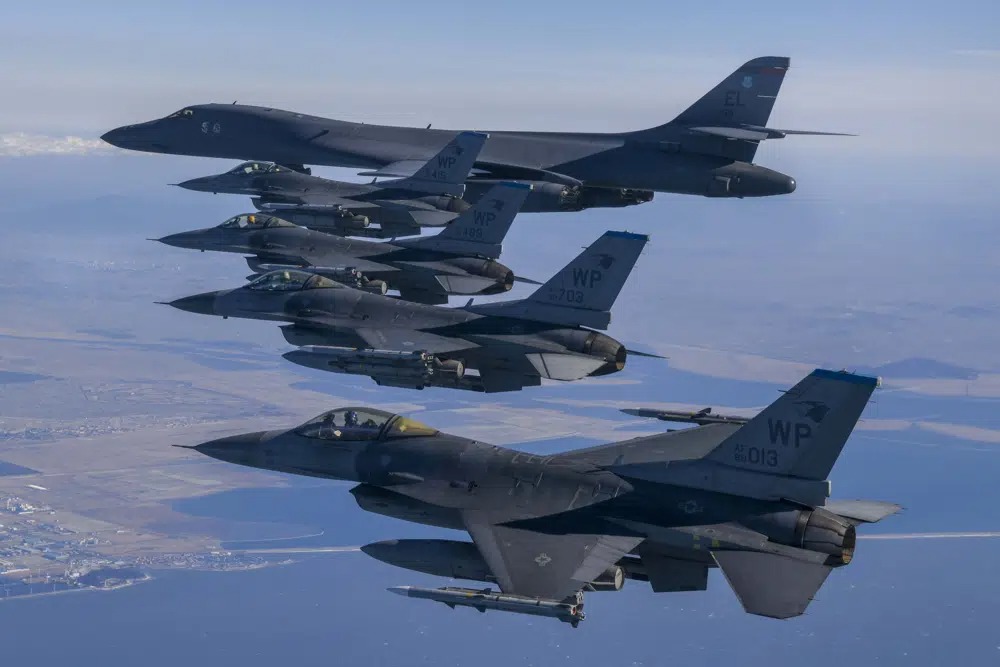North Korea said Sunday its latest intercontinental ballistic missile test was meant to further bolster its “fatal” nuclear attack capacity and threatened additional powerful steps over upcoming military drills between the United States and South Korea.
The United States responded by flying long-range supersonic bombers in a show of force later Sunday for separate joint exercises with South Korean and Japanese warplanes.
Saturday’s ICBM test, the North’s first missile test since Jan. 1, signals its leader Kim Jong Un is using his rivals’ drills as a chance to expand his country’s nuclear arsenal to get the upper hand in future dealings with the United States. An expert says North Korea may seek to hold regular operational exercises involving its ICBMs.
North Korea’s official Korean Central News Agency said its launch of the Hwasong-15 ICBM was organized “suddenly” without prior notice at Kim’s direct order.
KCNA said the launch was designed to verify the weapon’s reliability and the combat readiness of the country’s nuclear force. It said the missile was fired at a high angle and reached a maximum altitude of about 5,770 kilometers (3,585 miles), flying a distance of about 990 kilometers (615 miles) for 67 minutes before accurately hitting a pre-set area in the waters between the Korean Peninsula and Japan.
The steep-angle launch was apparently to avoid neighboring countries. The flight details reported by North Korea, which roughly matched the launch information previously assessed by its neighbors, show the weapon is theoretically capable of reaching the mainland U.S. if fired at a standard trajectory.
The Hwasong-15 launch demonstrated the North’s “powerful physical nuclear deterrent” and its efforts to “turn its capacity of fatal nuclear counterattack on the hostile forces” into an extremely strong one that cannot be countered, KCNA said.
Whether North Korea has a functioning nuclear-tipped ICBM is still a source of outside debate, as some experts say the North hasn’t mastered a way to protect warheads from the severe conditions of atmospheric reentry. The North says it has acquired such a technology.
The Hwasong-15 is one of North Korea’s three existing ICBMs, all of which use liquid propellants that require pre-launch injections and cannot remain fueled for extended periods. The North is pushing to build a solid-fueled ICBM, which would be more mobile and harder to detect before its launch.
“Kim Jong Un has likely determined that the technical reliability of the country’s liquid propellant ICBM force has been sufficiently tested and evaluated to now allow for regular operational exercises of this kind,” said Ankit Panda, an expert with the Carnegie Endowment for International Peace.
Chang Young-keun, a missile expert at Korea Aerospace University in South Korea, said that North Korea appeared to have launched an upgraded version of the Hwasong-15 ICBM. Chang said the information provided by North Korea showed the missile will likely have a longer potential range than the standard Hwasong-15.
Later Sunday, U.S. B-1B bombers and other aircraft separately trained with South Korean and Japanese fighter jets over and near the Korean Peninsula. A South Korean military statement said Sunday’s training reaffirmed Washington’s “iron-clad” security commitment to South Korea.
North Korea is sensitive to the deployment of U.S. B-1B bombers, which are capable of carrying a huge payload of conventional weapons.
The North’s launch came a day after it vowed an “unprecedentedly” strong response over a series of military drills that Seoul and Washington plan in coming weeks.
In a statement Sunday, Kim Yo Jong, the influential sister of Kim Jong Un, accused South Korea and the U.S. of “openly showing their dangerous greed and attempt to gain the military upper hand and predominant position in the Korean Peninsula.”
“I warn that we will watch every movement of the enemy and take corresponding and very powerful and overwhelming counteraction against its every move hostile to us,” she said.
North Korea has steadfastly slammed regular South Korea-U.S. military drills as an invasion rehearsal though the allies say their exercises are defensive in nature.
“By now, we know that any action taken by the U.S. and South Korea — however justified from the vantage point of defense and deterrence against (North Korea’s) reckless behavior — will be construed and protested as an act of hostility by North Korea,” said Soo Kim, a security analyst at the California-based RAND Corporation. “There will always be fodder for (Kim Jong Un’s) weapons provocations.”
“With nuclear weapons in tow and having mastered the art of coercion and bullying, Kim does not need ‘self-defense.’ But pitting the U.S. and South Korea as the aggressors allows Kim to justify his weapons development,” Soo Kim said.
U.S. National Security Council spokesperson Adrienne Watson said the U.S. will take all necessary measures to ensure the security of the American homeland and South Korea and Japan. South Korea’s presidential National Security Council said it will seek to strengthen its “overwhelming response capacity” against potential North Korean aggression based on the military alliance with the United States.
The South Korean and U.S. militaries plan to hold a table-top exercise this week to hone a joint response to a potential use of nuclear weapons by North Korea. The allies are also to conduct another joint computer simulated exercise and field training in March.
The foreign ministers of South Korea and Japan, meeting on the sidelines of a security conference in Germany on Saturday, agreed to boost a trilateral cooperation involving the United States and exchanged in-depth views on the issue of Japan’s colonial-era mobilization of forced Korean laborers — a key sticking point in efforts to improve their ties, according to Seoul’s Foreign Ministry.
South Korea and Japan are both key U.S. allies but often spat over issues stemming from Tokyo’s 1910-45 colonial occupation of the Korean Peninsula. But North Korea’s recent missile testing spree is pushing the two countries to explore how to reinforce their security cooperation.
(AP)











